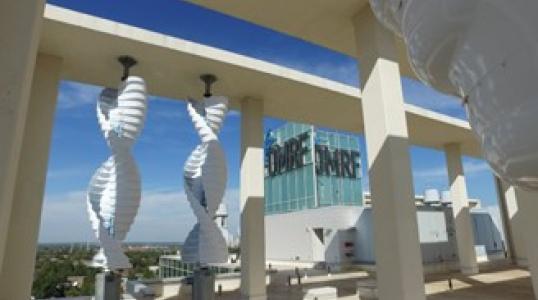Extramural Construction Programs
ORIP's Division of Construction and Instruments (DCI) supports programs that fund the construction, renovation, and modernization of research space by issuing Notices of Funding Opportunities (NOFOs) when congressional appropriations are available.
The overall objective of these programs is to provide modernized physical infrastructure that meets up-to-date engineering requirements to conduct cutting-edge NIH-funded biomedical research. Such an investment in infrastructure offers long-term benefits because federally funded space must be used to support biomedical research for the next 10 years, depending on the regulatory requirement of an individual program. These investments impact research funded by essentially all NIH Institutes and Centers, benefiting all areas of biomedical sciences from fundamental biology to clinical translational research.
ORIP oversees the use of more than 300 research facilities in 45 states and in Puerto Rico that were funded in the last 20 years. These facilities provide new laboratory space, and set up environments for specialized research protocols and clinical investigations. For example, special facilities support antibody engineering for the development of cancer therapeutics and the synthesis of probes for positron emission tomography. The projects created designated space, such as barrier facilities to study pathogens and prions, animal facilities in nonhuman primate research centers to research infectious diseases, and shielded rooms for magnetic resonance imaging.
C06 Opportunity Forecast
https://grants.gov/search-results-detail/359701
Office Hour
Wednesdays: 2–3 pm ET
Join via Teams
No advanced reservation is required.
Expired C06 NOFOs
Award Budget: $2M to $8M
Deadline: January 27, 2025
Award Budget: $2M to $4M
Deadline: January 7, 2025
American Recovery and Reinvestment Act (ARRA) Program
The American Recovery and Reinvestment Act of 2009 (ARRA) created a $1 billion investment for the construction and renovation of biomedical research facilities across the United States. This budget comprised approximately 10% of the total NIH ARRA funding appropriation. The ARRA investment was expected to stimulate the nation’s economy by creating and maintaining American jobs. A total of 148 ARRA awards were granted through ORIP to support the construction or renovation of 64 animal facilities, 56 research laboratories, 17 clinical research facilities or laboratories, 8 imaging facilities, and 7 data centers. These facilities have helped enable research in a broad array of scientific areas, including HIV/AIDS, aging, cancer, cardiovascular diseases, respiratory diseases, and infectious diseases. Read more about ORIP-supported ARRA awards, including several featured awardees.
ORIP oversaw and supported other special initiatives, such as the Extramural Research Facilities Restoration Program: Hurricane Sandy Disaster Relief, to recover the biomedical research capacity in affected states. Two ORIP grant awards funded the rebuilding of rodent housing facilities and laboratory research space that were lost because of hurricane damage.
Since its creation, ORIP has directed significant efforts toward the modernization of animal research facilities. The funded projects, based on current technologies and engineering principles, improve resource efficiencies, contribute to the accuracy of experimental protocols, and benefit animal care.
Various environmental factors may affect the physiology, metabolism, responses to drugs, and other experimental outcomes at the genetic, cellular, and whole organism levels. For example, a rodents’ ability to hear high-frequency sounds makes them sensitive to noise and vibrations that are generated by heating, ventilation, and air conditioning (HVAC) units in a laboratory setting. Modern HVAC units provide an improved environment for research animals. Similarly, new automated systems monitor and adjust light cycles and intensity to match natural circadian rhythms of animals. The installation of robotic feeding and watering systems allow accurate assessments of caloric intake, eating patterns, and food preferences. Often, new biological discoveries necessitate the modernization of laboratory space, so that targeted experimental protocols can be performed under well-defined conditions. For example, a gnotobiotic environment is needed to conduct some studies that research the role of the microbiome in health and disease.
Based on the aforementioned examples, the creation, renovation, and modernization of infrastructures are necessary to support cutting-edge biomedical research. Emerging scientific fields require the support of novel and advanced engineering solutions to conduct robust and reproducible biomedical research. ORIP’s long-standing experience in supporting successful improvements to infrastructures, demonstrates its ability to continue these efforts.







